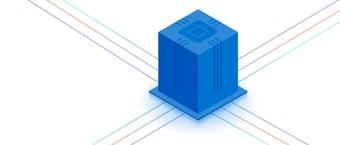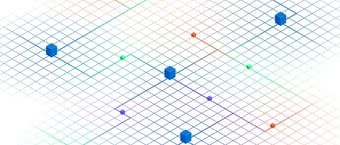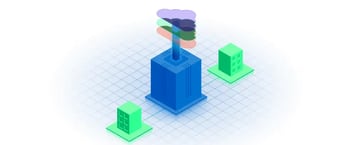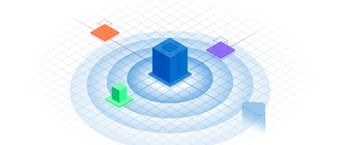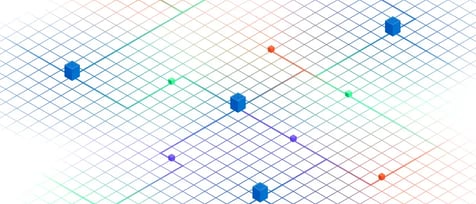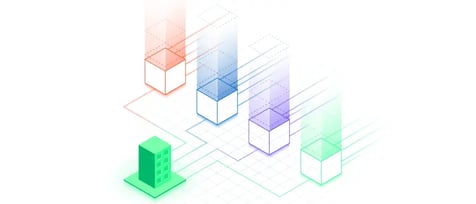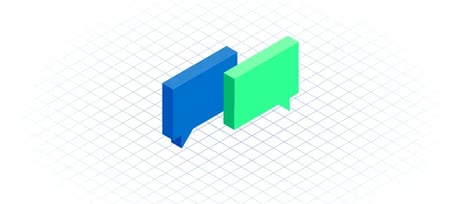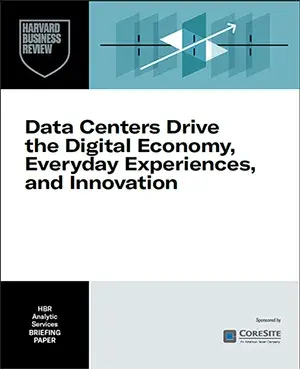
How Colocation Data Centers Are Helping Solve the Power Density Challenge
Intense number crunching requires more power than ever before, and the metric to watch is power density, the amount of power used by a fully populated server rack, measured in kilowatts (kW) per rack. In turn, power density increases are causing strategic shifts in data center operations. The high-performance computing (HPC) bucket includes artificial intelligence (AI) workloads, big data analytics and the data processing associated with smart devices. These technologies are used to run businesses, conduct research, build products, advance healthcare and more.
The Rise in Data Center Power Density
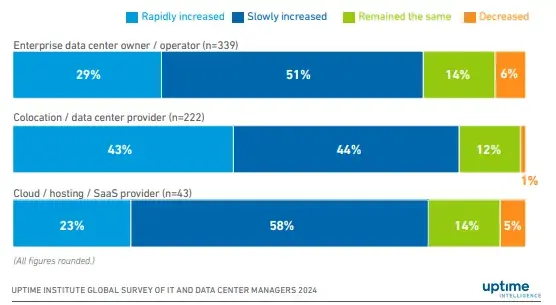
Source: Uptime Institute
Reported leaps in rack density vary, but an upward trend is consistent. According to the 2025 State of the Data Center Report from AFCOM (Association for Computer Operations Management) rack density jumped from 7 kW/rack in 2021 to 16 kW/rack. Furthermore, 79% of respondents to the survey for the report expect rack density to grow further, due to AI and other high-performance workloads.1
The Uptime Institute Global Data Center Survey 2025 states, “Average server rack power densities continue to rise slowly, driven by greater adoption of racks in the 10 kW to 30kW range.”2 And, according to Steven Carlini, Vice President of Innovation and Data Center, Energy Management Business Unit, Schneider Electric, “When fully loaded into a rack, the latest NVIDIA-based GPU servers require 132 kW of power – and densities continue to increase. The next generation, expected in under a year, will require 240 kW per rack.”3
How AI and HPC Drive Higher Data Center Power Density
More power per rack makes high-performance computing possible. Notable HPC workloads include cryptocurrency mining, blockchain, high-definition video streaming, gaming and virtual reality. The following technologies, however, lead the pack when it comes to requirements for high-density power data center architectures and specialized hardware.
- Artificial Intelligence – We encounter AI everywhere. Businesses are ramping up the use of AI to support decisions related to customer service, product/service design, efficiency, cost savings, strategic planning, financial modeling and more. Vertiv CEO Giordano (Gio) Albertazzi comments, “With AI driving rack densities into three- and four-digit kWs, the need for advanced and scalable solutions to power and cool those racks, minimize their environmental footprint and empower these emerging AI Factories has never been higher.”5
- Data Analytics – “Deluge” only begins to describe the amount of data being collected and analyzed for use cases including scientific research, engineering, healthcare, finance, business intelligence, software development and IT operations. DemandSage states that “90% of the world’s data has been created in the last two years.”6 Analysis requires high-performance computing to make sense of the data and allow data analysts to slice and dice their findings.
- Internet of Things (IoT) – IoT device adoption is expected to surge to 40 billion by 2030. Two-thirds of all devices worldwide are IoT-enabled.7 The IoT requires real-time data processing for billions of smart devices connected to the internet. Industrial sensors, connected vehicles, home appliances, wearables, smartphones and voice assistants like Google Nest are just a few types of smart devices. The data from smart devices feeds initiatives such as predictive analytics for product lifecycles and maintenance requirements, simulation models that predict how products will perform in the real world. As the number of smart devices rises, demand grows for edge computing, special AI hardware and hardware accelerators.
Data Center Strategies for Managing Power Density Growth: Colocation and Cloud Direct Connect
Considering current and future power density requirements, data centers are tackling the challenge in multiple ways. AFCOM’s take is that “many data center managers are focused on improving airflow, adopting liquid cooling and leveraging new sensors for enhanced visibility.”8 AI, of course, is a thread in these initiatives.
Colocation and direct cloud connection are top strategies to manage power density. Many enterprises choose to colocate infrastructure, so they don’t have to invest in and manage power density in their own data centers.
A direct cloud connection is a dedicated link to a cloud within a colocation facility. A cloud direct connect to a major cloud provider offers a reliable, economical approach to running HPC and AI workloads because it transfers large data sets with low latency, high availability and substantial savings on data egress costs.
Editor’s note: This blog was originally published as “Facing the Data Center Power Density Challenge.” It has been updated with new references and up-to-date industry insights.
Know More
To help technology leaders navigate the evolving demands of hybrid IT, Harvard Business Review Analytic Services in association with CoreSite commissioned an in-depth report on the future of digital infrastructure. This independent analysis highlights how enterprises are using colocation and interconnection to:
- Power AI and data-intensive workloads
- Improve sustainability and operational efficiency
- Create scalable, future-ready environments
Get the Harvard Business Review Analytic Services Report
References
1. AFCOM, 2025 State of the DataCenter Report (source)
2. Uptime Institute, Global Data Center Survey 2025 (source)
3. Forbes, Why Liquid Cooling for AI Data Centers Is Harder Than It Looks (source)
4. Uptime Institute, Global Data Center Survey 2024 (source)
5. Vertiv, Data Center Trends 2025 (source)
6. DemandSage, Big Data Statistics 2025 (Growth and Market Data) (source)
7. DemandSage, How Many IoT Devices Are There (source)
8. AFCOM, 2025 State of the DataCenter Report (source)


